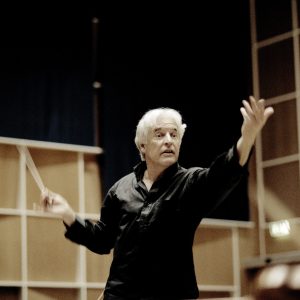Skuster Triumphs in Mozart Oboe Concerto
Her control of the long, sinuous lines of the Adagio non troppo was admirable, and she endowed these themes with a dreamy, floating quality that could compete with the best operatic soprano for sheer sensuous allure. Although experiencing an oboe concerto in a symphony concert is rare, Skuster’s performance should give timid programmers second thoughts.
Guest conductor Gilbert Varga opened the concert with Franz Joseph Haydn’s Symphony No. 1 in D Major. The energetic British conductor of Hungarian descent displayed an amicable affinity for these works from the Classical period, keeping textures light, crisp, and buoyant. For both works, the orchestra was appropriately reduced in number, and Varga coaxed an unusually sweet, unified sonority from the musicians. They appeared to enjoy his large, clean gestures and animation on the podium.
Given Varga’s ethinic background—his father was the celebrated Hungarian violinist Tibor Varga—his choice of Zoltán Kodály’s Suite from his 1926 opera Háry János, a Singspiel based on a comical Hungarian story that is filled with Hungarian folk songs, seemed almost foreordained. Varga relished every humorous and satiric moment of this cleverly orchestrated suite from the opera, and the orchestra responded with gusto, especially the brass choirs.
If the suite’s opening movement seemed a bit unfocused, once those Viennese musical clocks began to chime in the
second movement, the percussion and wind players had a field day. Acting Principal Viola Thomas C. Turner intoned a wistful solo at the beginning of the third movement, answered by oboe and other winds accompanied by the warm buzz of the cimbalom, played by Laurence Kaptain. Some nationalities claim a distinctive musical instrument as their cultural symbol—the Scots have their bagpipes and the Norwegians their Hardanger fiddles—and the cimbalom, a kind of hammered dulcimer housed in an ornate oblong wooden case—is uniquely Hungarian.The movement entitled “The Battle and Defeat of Napoleon” gave the brass players ample opportunity for fortissimo shrieks and gnarly fanfares, and the lone saxophone player intoned a sultry solo at the climax of the otherwise boisterous movement. The finale engaged the whole orchestra in a rollicking joy ride, which aroused serious audience approval.
Maestro Varga conducted one more piece, Guiseppe Martucci’s “Notturno,” an infrequently chosen pastel that distributes short, juicy solos like a generous Santa visiting a beleaguered orphanage. I fear, however, that Hollywood’s plush movie scores of the 1930s and 1940s have made works like this “Notturno” redundant.
[box] This San Diego Symphony concert at the Jacobs Music Center’s Copley Symphony Hall was presented Friday, March 21, at 8:00 p.m. It will be repeated Saturday, March 22, at 8:00 p.m. and Sunday, March 23, at 2:00 p.m.[/box]

Ken Herman, a classically trained pianist and organist, has covered music for the San Diego Union, the Los Angeles Times’ San Diego Edition, and for sandiego.com. He has won numerous awards, including first place for Live Performance and Opera Reviews in the 2017, the 2018, and the 2019 Excellence in Journalism Awards competition held by the San Diego Press Club. A Chicago native, he came to San Diego to pursue a graduate degree and stayed.Read more…

![Sarah Skuster [photo (c) Beth Ross Buckley]](http://www.sandiegostory.com/wp-content/uploads/2014/03/SarahSkuster_BethRossBuckley7791-300x199.jpg)

Great programing! Your review left me wishing that I’d been there.